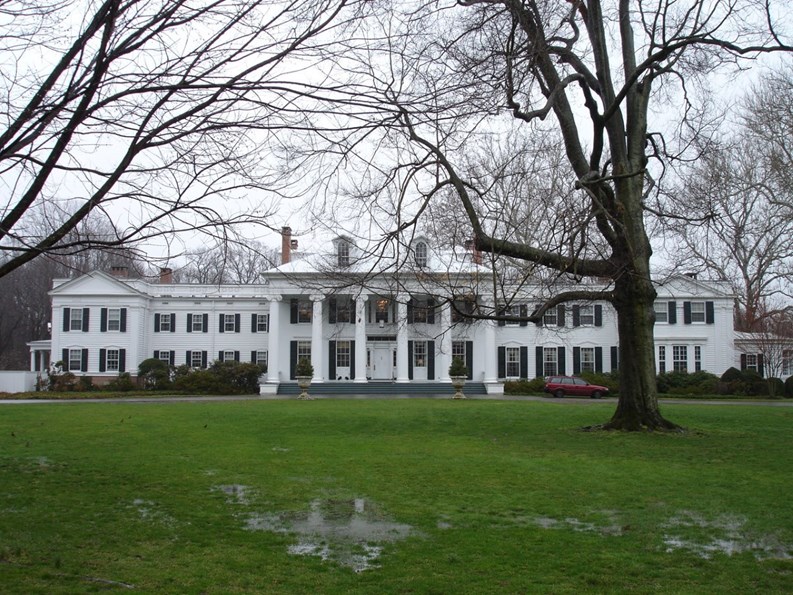When one thinks of Princeton, New Jersey, the first thing that comes to mind is the Ivy League university that put the town on the map—and with good reason. Perennially ranked in the top handful of colleges in the country and with an endowment roughly equivalent to the GNP of a small developing country, Princeton University is the alma mater of (to name just a smattering) presidents James Madison and Woodrow Wilson, the Dulles brothers, Donald Rumsfeld, Ralph Nader, political pundit George Will, numerous state governors, senators, and congressmen, the playwright Thorton Wilder and filmmaker Ethan Coen. F. Scott Fitzgerald wrote This Side of Paradise while a Princeton undergraduate, and the faculty has boasted luminaries like New York Times economics columnist Paul Krugman, Federal Reserve Chairman Ben Bernanke, religion scholar Elaine Pagels and, at the Institute for Advanced Study, an erstwhile Swiss patent clerk named Albert Einstein.
“The college students infuse a young, energetic feeling to the place,” says Aqualine Suliali, who has worked and lived in the area for six years. “You get an Old World feeling because of the history, but it’s also new and exciting.”
At first, Einstein disliked his new place of residence, calling Princeton “a quaint and ceremonious village of puny demigods on stilts.” But its quaintness and ceremony apparently won him over, and he lived the last twenty years of his life in what is one of New Jersey’s oldest and most historic towns.
While the university certainly contributes much to the flavor of the town, not to mention its economy, there is more to Princeton than Princeton. The governor’s mansion, with the Harry Potterish name of Drumthwacket, is not in nearby Trenton, the capital, but in Princeton. The Educational Testing Service, better known as ETS—the academic outfit responsible for overseeing the SATs and GREs—is based in Princeton, as is the Robert Wood Johnson Foundation, Siemens Corporate Research, Opinion Research Corporation and Dow Jones & Company.
Among Princeton’s 30,000 residents, then, are some of New Jersey’s most important movers and shakers. Not that you would know it. Princeton is too venerable to be ostentatious— it’s part of its charm.
A Little History
Princeton was settled in the late seventeenth century. The eponymous “prince” was William of Orange and Nassau, whose color was adopted by the university, which was initially established as the College of New Jersey in 1756. At first, the entire college was housed in Nassau Hall, the largest academic building in the colonies. To this day, “Old Nassau” refers to the building, the university and its alumnae.
In 1777, George Washington scored a decisive victory over the British at the Battle of Princeton. Five years later, the Continental Congress convened at Nassau Hall, making Princeton the nascent country’s capital, at least for a few months. It was there that the Congress learned that the Treaty of Paris had been signed, ending the Revolutionary War.
Princeton was the overnight stagecoach stop on the Trenton-New Bruns-wick line until midway through the 1800s. When a railway line was built connecting New York and Philadelphia, Princeton was one of the stops. Such was the draw of Princeton that when the rail line was subsequently shortened, and moved south of the town, a spur was built connecting Princeton with the main line.
Woodrow Wilson, a president of Princeton University and later governor of New Jersey, was elected president of the United States in 1912. The reform-minded chief executive presided during the First World War and helped restore a progressive mindset to the Democratic Party.
Notable Princetonians—residents of the town, not students at the college—include Grover Cleveland, George Gallup, J. Robert Oppenheimer, Paul Robeson, and members of the bands Phish, The Spin Doctors and Blues Traveler.
Geography
Princeton is technically not one place, but two: the borough, which contains the university and Nassau Street—which forms the center of town—and the township, comprising the borough’s environs. The schism was the result of a dispute over school taxes in 1896. Enthusiasm for a reunion, while thrown up for vote every now and then, has yet to win at the ballot box.
One of Princeton’s many selling points is its location. Roughly equidistant from New York and Philadelphia, Princeton is convenient to both via rail. Indeed, many Princetonians are economically dependent on one city or the other.
“Historically, a lot of people who had money were traveling to New York or Philadelphia,” says Eileen Morales, curator of the Historical Society of Princeton.
Located in Mercer County, where median home prices were tabulated at $252,400 in the first quarter of 2009, according to the New Jersey Association of Realtors (NJAR)—Princeton boasts homes listing for eight figures that look like Hollywood set pieces.
“Compared to other neighborhoods in Mercer County especially, it’s very affluent,” says Suliali.
With the affluence comes another prerequisite: an extremely low personal crime risk. The national average for the metric is 100, with a low score indicating less likelihood of crime. According to HomeInsight, Princeton scores an anemic six for personal crime risks. (By contrast, Elizabeth, where the College of New Jersey was founded, and which is in the midst of a mini-renaissance of its own, is a whopping 194).
Another feather in the Princetonian cap is the school system, which continues to improve with each passing year.
“The education system is continually lauded,” says Morales. “Princeton High School is one of the best high schools in the state—in the country.” The private school options, including Princeton Day, are also noteworthy.
There are still more draws to the town.
“The culture, the community, Princeton Museum, McCarter Theatre, the ability to walk the kids to an ungodly amount of parks,” lists Josh Wilton, manager of Weichert Realtors in Princeton and the former president of the Mercer County Association of Realtors. “There are more parks in Princeton than there are people.”
Demographic
Who lives in Princeton? College students, college professors, politicos, artists, think tankers, seminarians, restaurateurs—there are 2,444 places to eat within 15 miles of the university—hedge fund managers, financiers and Democrats. This is a blue town in what has become one of the nation’s bluest states.
Ethnically, the population has always been a mélange of different cultures, races and ethnicities.
“Princeton has always been fairly diverse ethnically, beginning with the earliest settlers,” says Morales, who were Quakers of both English and Dutch extraction.
The 1830s saw waves of immigrants from famine-torn Ireland. “They helped build the Delaware & Raritan Canal,” says Morales.
Italian immigrants lent their labor to the construction of many of the university buildings a few decades later. There was always an African-American presence in Princeton. “There was a free Black community concurrent with the Quakers,” says Morales.
In the 20th century, immigrants from Hungary, Korea, Southeast Asia, Haiti and Guatemala added to the mix. All this diversity, plus the constantly changing student body, make Princeton a rich, vibrant place.
“It’s unique,” says Wilton. “There’s a diverse demographic you don’t find in most towns.”
Mix is a key word to describe the place: a mix of young and old, big and small, collegiate and professional, middle class and upper crust.
Real Estate and the Future
There is no cooperative housing in Princeton—although one of those big old mansions would make one heck of a co-op—but there are many condominiums.
“There are no co-ops in town,” says Carol Mucerino, branch manager at Gloria Nilson GMAC Real Estate in Princeton. “However, there are condos, townhomes, patio/homes to single family homes, of which some are historical homes, estates and farms as well.”
In the rental market, one-bedroom apartments can go for $1,400 per month.
While Princeton is not immune to the national downward trend in real estate, the town is so coveted—and so geographically small—that the market remains active.
“Real estate is local. There’s no broad brush to paint the real estate market with,” says Wilton. “But if you go to an open house on Sunday, and there are 60-80 people at the open house—what does that tell you?”
What it tells us is that there is demand for the best houses at the best prices in the best locations in town. Princeton is a place families make sacrifices to live in, Wilton notes. The classic eight room, four bedroom, two-and-a-half bath colonial that can be had in nearby West Windsor is out of the price range of most people house shopping in Princeton (they can list in the seven figures there).
“You have to be willing to sacrifice things,” Wilton says. “Space, price—you sacrifice the fourth bedroom for being able to walk your kids to school.”
“So where is Princeton going in the next few years?” says Mucerino. “I say it will always be desirable, but is not immune to the changes in the real estate market—just not as much as some other areas.”
This is not to say that everything is rosy. As with any popular place to live, Princeton has been hurt somewhat by its reputation.
“In the last 25 years, Princeton has lost some of its small-town feel,” says Morales, “especially with the commercial businesses in town. The mom-and-pop stores have been taken over by chains.”
Then there is the traffic. Princeton is, in terms of design, a small town. It is not built like a city, and cannot comfortably accommodate huge volumes of cars.
“There’s an influx of people,” says Morales. “People are always complaining about parking.”
But if the worst you can say about a place is that it’s getting crowded because so many people want in, you have to be doing something right. Once Einstein moved to Princeton, he never left, and he was no dummy.
Greg Olear is a freelance writer and a frequent contributor to The New Jersey Cooperator.







Leave a Comment